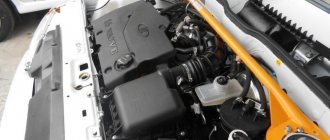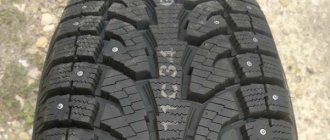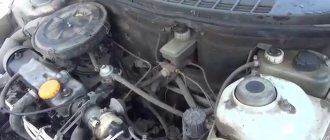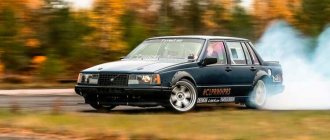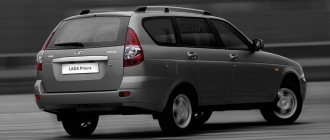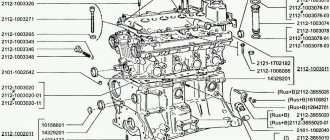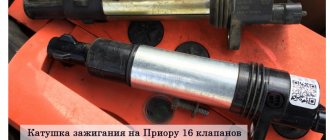Overall dimensions of VAZ-2110 cars, 2111, 2112
VAZ-2110 is a front-wheel drive passenger car with a transverse power unit, designed for use on paved roads.
The body is all-metal, monocoque, four-door, sedan type. To transport large and long cargo, the rear seat can be folded, thereby increasing the trunk volume.
Engines are four-cylinder, carburetor or with various fuel injection systems, with a displacement of 1.5 liters. Thanks to the front-wheel drive layout, the car has improved handling characteristics compared to rear-wheel drive VAZ models, especially on slippery roads and when cornering.
It is possible to equip the car with fog lights, heated front seats, electric windows, an on-board computer, a catalytic converter in the exhaust system, electric exterior mirrors, an electronic anti-theft system, air conditioning, anti-lock brakes, an airbag, and a sunroof.
The graphs show the dimensions of the VAZ 2112 car - width, length and height. Data is shown for all available modifications, including, for some, the overall width with mirrors.
The smallest cars are marked in green, and the largest in red.
Below is a summary table of overall dimensions for all modifications of the VAZ 2112.
On a VAZ 2112, the geometric dimensions of the body will definitely be needed by the owner who intends to independently correct or restore the parts. The situation on the roads has been extremely depressing lately. Due to the large number of vehicles, motorists are more likely to be involved in accidents, major and minor. The owners of “two-wheelers”, of whom there are a lot in Russia, are no exception in this regard. Find out from the article how the geometric dimensions of the VAZ 2112 body affect the ease of driving and which parts on this model are most quickly subject to deformation.
History of creation
The VAZ 2112 hatchback model was produced since 1999, becoming the successor to the 2110 sedan and 2111 station wagon. The “Twelfth” became a close analogue of the famous tenth model, but had a slightly shortened body. As planned by the manufacturers, the 2112 was supposed to combine all the advantages of the “ten” and “eleven”, so the five-door hatchback was chosen as the body type.
VAZ-2112 Pre-production (1994)
The 12th model began to be mass produced in 2000; it lasted 8 years on the assembly line. Unlike the sedan and station wagon of the tenth series, the assembly of the “dvenashka” was not transferred to the Ukrainian ones.
Although the twelfth model was positioned as an improved “ten”, the improvements here are very conditional and not always obvious. Therefore, the difference between these two models is not too big. AvtoVAZ designers continued to look for new solutions, as a result of which other lines and modifications appeared, which also have both their pros and cons.
Tens body care and repairs
Do-it-yourself VAZ 2110 body repair
The overall body of the “ten” looks more reliable, durable and resistant to corrosion. All-metal and partially galvanized, it comes off the assembly line already treated with anticorrosive, ready for harsh operating conditions.
On the other hand, we must pay tribute to our car owners, who are accustomed to finishing everything with their own hands. In particular, while remaining adherents of the domestic automobile industry, they turn a blind eye to the differences and shortcomings of technology in comparative terms and take additional care of the body so that it serves for many years without problems. Russian car owners almost always add special protection to the standard anti-corrosion treatment.
VAZ 2110 body repair and polishing
Preventative work specifically involves tinting the bottom of the car, treating sills and fender liners with Movil.
Note. We can say with confidence that among the “dozens” with high mileage, even today you can find examples that have been so well cared for by the owner that they look like new.
People's love for the “ten” is also symbolized by the succinct names given to the car by amateurs. “Matryoshka”, “pregnant antelope”, “chubby” - all these nicknames, albeit with some degree of irony, speak of love for the car. If at first the unique, new design of the VAZ model raised questions, then over time the angular shapes of the “bow” and “stern” became familiar.
Here are the preventive works that are usually carried out on the body of the “tens” throughout the entire operational period:
- Caring for paintwork;
- Lubrication of metal components of the body;
- Cleaning of technical holes;
- Periodic anti-corrosion protection of the body as a whole and treatment of hidden areas;
- Noise insulation;
- Sealing.
VAZ 2110 body repair
To protect the original paintwork of the body, you must be able to select the appropriate polishes and follow the rules for their application. In addition, the VAZ 2110 must first be washed when the car is new, only with cold water, and for treating paintwork, use polishes that do not contain abrasives.
Caring for the paintwork of a car with a 3-5 year mileage implies a different scenario:
- Use products for weathered surfaces (they contain a certain amount of abrasive).
Accordingly, for a body older than 5 years:
- Use products specifically designed for aged surfaces.
It is also recommended to polish the body in small areas by hand using clean flannel. This is done to prevent the polish from drying out during application.
Polishes PMA-1 and PMA-2 have proven themselves well.
Body polish
More good tips on the body in general:
- Do not store the car under rubber covers;
- Do not place rubber objects on painted surfaces (they will leave stains that are almost impossible to remove);
- Protect the paintwork from contact with alkalis, brake fluid and other chemicals that can destroy the coating.
It is recommended to lubricate rubbing parts and body elements from time to time in order to increase the durability of the metal frame. So, this should be done at least every 15 thousand km of the car or once a year.
Here's how and where to do it:
- Apply engine oil to door hinges;
- Apply CV joint grease-4 or Molikot to the limiters;
- Lubricate door locks with FIOL-1;
- Apply VTV-1 aerosol lubricant to the lock cylinders;
- Use the same product to lubricate the hinges and springs of the fuel tank hatch;
- Lubricate the hood lock with FIOL-1;
- Use the same tool to lock the trunk lid.
Anticorrosive treatment also needs to be given great attention. Hollow parts of the body and parts located in the lower part are most susceptible to the negative effects of rye (they are constantly exposed to moisture and dirt due to their close location to the road surface).
It has proven itself well for protecting the metal components of the body from corrosion. As for the treatment period, it is recommended to carry it out every year.
Due to the complexity of the work, it is recommended to treat hidden body cavities with anticorrosive agents at a service station. If the garage has the appropriate tools and equipment, then the process is as follows:
- The car is placed on a jack;
- The casing and all components that interfere with access to hidden cavities are removed;
- The holes are washed until clean water flows out;
- The surfaces are thoroughly dried, and all areas where the anticorrosive is applied are blown with compressed air.
The table below shows hidden cavities and how to apply anticorrosive.
Exterior
Looking at the “twelve”, it immediately becomes clear that its prototype was the “ten”. Externally, these two cars are very similar, it is immediately clear that they belong to the same family: the same rounded, smooth lines and roundness of the body, the same heaviness, especially in the rear of the car. Of course, whether you like the design of the car is a matter of taste. Many note that the twelfth model is the most beautiful of the entire line.
Lada 2112 (1999–2008)
It is also noticeable that the designers tried to give the car some sportiness by adding a rather large spoiler to the trunk door, rounding the body as much as possible and replacing the thirteen-inch “tens” wheels with 14 inches. However, despite all the developers’ tricks, it’s quite difficult to call the 12th Lada sports. Changes also affected the roof of the car. Here it is more sloping, making the car look more interesting. The body length of the 2112 model is slightly shorter than that of the “ten”.
If we compare the car with the 11th model, then the rear door is noticeably larger, which can be opened both from the outside using the key and from inside the cabin by pressing the corresponding button. But the fifth door opens only if you pull it on the plastic spoiler, which does not have a positive effect on it.
Lada 2112 (1999–2008)
The trunk, like the hood, boasts gas struts. It is convenient to load, the volume is 400 liters. The shelf in the trunk rattles and knocks a lot when driving. You can get into the car through the trunk door if all other doors are blocked or jammed.
Ground clearance VAZ 2110 ground clearance - photo, description on VAZ-2110.net
Dimensions and dimensions of Renault Sandero Stepway
However, the low ground clearance does not allow you to move with confidence...
VAZ of the tenth family is that, if necessary, automatic...
If you prefer to load your car to capacity, then...
Geely CK, Lanos, Lada Priora interior dimensions and dimensions.
“Raised” VAZ 2110.
Selling used auto parts VAZ window lifter in Cherepovets.
CROSS20 suspension kit, increasing the ground clearance of your car by 30-50...
Model 1111 Oka 2101 2102 2103 2104 2105 2106 2107 2108 2109 21099 2110 211…
upper rear suspension on VAZ 2110.
This car, however, like its predecessor VAZ-2110
passenger car VAZ 2110.
Brands of cars and cars Cars and prices. clearance_VAZ_2110_klirens_vaz_2…
Club forum VAZ 2113, VAZ 2114, VAZ 2115 - Show message separately - Co...
Disassembling the VAZ 2112 panel.
All Today I got to two boundary stones (in my VAZ 2110).
Repair of VAZ rear axle gearbox, Repair of Renault Traffic steering rack, Repair…
Device LADA 2110 (VAZ 2110).
What is vehicle clearance?
vehicle ground clearance.
Installation of houses on VAZ 2115.
Interior
The interior of the car is simple and not very presentable. You won’t find any “bourgeois excesses” here. The only exception is electric windows and heated front seats, but this is not found in all modifications of the car.
The steering wheel is large and very antediluvian. The steering column is height adjustable only. Moreover, some models come without power steering and electric power steering, which is a significant disadvantage.
Torpedo Lada 2112 (2006-08)
To the right of the steering wheel is a console with a heater, radio, on-board computer (if equipped) and main keys. The heater, in theory, should be adjustable in order to separately heat the windows, top and bottom of the cabin, but in reality everything is heated at once. There are no airbags in the cabin.
The glove compartment is quite large and even has a backlight. The position of the exterior mirrors is adjusted by a special lever, but it is adjusted very mediocrely, so usually no one uses it.
A tall person is unlikely to be comfortable in the back row of seats, because his head will touch the ceiling. Long-legged people will also not be very comfortable, since there is quite a bit of space left to the front seats. The width of the cabin is cramped; only two passengers can be comfortably accommodated. Three people will fit, but they will be cramped.
Interior of Lada 2112 (1999–2008)
The rear windows are manual and constantly stick. As anyone who has ever owned a Lada, Zhiguli or any other AvtoVAZ product knows, the windows go down exactly to the level they want. Often it is completely impossible to lower the glass completely; it gets stuck in the middle and does not move anymore.
The rear row seats recline together or separately, which increases the size of the trunk, so you can put a fairly large load in the car.
Length
The geometry of the VAZ 2110 body is described in the operating instructions. The main parameters for checking body geometry are as follows:
- There should be 4.265 meters between the extreme points of the front bumper and the rear bumper.
- The distance between the center of the front wheel and the center of the corresponding rear wheel is 2.492 meters.
- The distance from the center of the front wheel to the end point of the front bumper is 0.829 meters.
- The distance from the center of the rear wheel to the end point of the rear bumper should be 0.944 meters.
The height of the car is always stationary - 1420 mm
You should try to avoid welding and other work that involves thermal heating of the metal.
Engine modifications
Under the hood of Lada 2112 (1999–2008)
In total, there are 6 engine modifications for the VAZ 2112:
- 21120 – the basic version of the 1.5 liter internal combustion engine. The disadvantage is the presence of free space inside the cylinder head and the block itself.
- 21124 – increased power (up to 89 hp) and increased engine capacity (up to 1.6 liters).
- 21126 – power increased to 98 hp. with an engine capacity of 1.6 liters.
- 21127 – the volume is still 1.6 liters, but the power is increased to 106 hp.
- 21128 – power is 105 horses, which is achieved by increasing the volume of the combustion chamber (1.8 liters). The problem with the valves bending has been resolved.
- 21129 – the engine has a volume of 1.8 liters, a phase shifter has been added.
Design
If we talk about the design itself, then everything is very simple and quite interesting:
- The 2112 engine is based on a four-stroke operating principle with distributor fuel injection.
- All cylinders are arranged in a row, which is very good. Due to this, it is possible to obtain high power and low fuel consumption.
- The power unit has one crankshaft with an overhead camshaft. They allow all cylinders to work without interruption.
- It is also worth noting that the power unit is equipped with a closed-type liquid cooling system. That is, getting to it is not very easy; you will have to disassemble most of the units.
- A small feature of the VAZ 2112 engine includes a combined lubrication system: a special liquid is supplied under pressure and sprayed. This technology makes it possible to lubricate almost all mechanisms and parts of a modern unit. Plus, it will last much longer than other companies.
- VAZ specialists say that they are using a completely new method of honing cylinders.
Options
Lada 112 Coupe (2002–06)
The car was produced in several versions:
- 21120 – basic version with a 16-valve 1.5-liter engine with multipoint injection. Equipped with 14-inch wheels. Engine power – 93 hp.
- 2112i – version with fuel injection system.
- 21120 GLI (Gran Luxury Injector) – luxury version of the car.
- 21121 – modification with an engine capacity of 1.6 liters. Power – 81 hp
- 21122 – simplified, budget option. It was produced without electric windows, with 13-inch wheels and brakes from the VAZ 2108.
- 21123 Coupe - a three-door version, the so-called “coupe”, although in fact it is an ordinary three-door hatchback. It was assembled individually and in limited edition. The coupe's body is more rigid, as is the suspension. Handling is better than the standard version. The car was expensive, produced in 2002-2006.
- 21124 – injection version with a 1.6-liter engine. By increasing the depth of the groove in the piston crown, the creators managed to solve the problem of valve bending, which plagues the standard version.
- 21128 – modification with a 1.8-liter engine. Power – 105 hp.
- 2112-37 – racing version with a 1.5 liter engine, equipped with a roll cage.
- 2112-90 “Tarzan” – version with all-wheel drive. A Niva engine (1.7 and 1.8 liters) was installed.
VAZ-2111
The previous modification of a similar body design – the legendary 2104 (“four”) – was already 15 years old by the time the production of 2111 began. VAZ-2111 is the first VAZ station wagon with front-wheel drive.
The trunk volume with a total vehicle load capacity of 500 kg varies from 490 to 1420 liters. This is due to the fact that the rear seats can be folded in such a way as to create a flat horizontal floor, and the backrest, if necessary, can easily be folded out in a ratio of 1:2. If there is a luggage structure, an additional 50 kg of cargo can be placed on the roof. Also, with a towbar, it is possible to tow a trailer up to 1000 kg, equipped with brakes. The car body is mounted on a supporting frame with rubber-metal elements, on which it rests at 10 points. Thanks to this solution, it was possible to reduce the level of vibration and noise in the cabin, and the body became stronger and more durable. The choice of engines for the 2111 is similar to the sedan. There is also a 21110 with an eight-valve 1500 cc engine. cm with a power of 76 l. With.; 21111 with a carburetor engine (from a VAZ-21083) with a volume of 1500 cubic meters. see and 21113 with a sixteen-valve engine with a capacity of 1600 cc. cm increased power.
There were also 3 configuration options - “standard”, “luxury” and “norm”. In 1997, together with the AVTOVAZ Research and Development Center, the DECON design group created a new comfortable SUV and called it “Tarzan”. The car is a hybrid of the body structure and frame chassis of the front-wheel drive models of the “tenth” family with transmission elements and main suspension components from the Niva (2121). Moreover, all units, except for the elongated cardan shafts and the frame itself, are serial.
Specifications
Visibility
Visibility in the cabin is good, everything is perfectly visible from the driver's seat, the glass area is large. However, the rear view is partially blocked by the spoiler.
Body
The bodies of all Lada cars leave much to be desired. They are made of thin and very low quality metal that rusts instantly. The sills, arches and lower parts of doors are most susceptible to corrosion. If you find a VAZ 2112 in good condition, then both the arches and the sills will probably be overcooked.
Mileage
If you monitor the car and the condition of the engine, then the VAZ 2112 can “run” up to 200-250 thousand, which is not too much. On the other hand, the engine can be rebuilt or a new one installed, because Lada engines are obscenely cheap.
Lada 2112 (1999–2008)
The fuel consumption of the “twelfth” cannot but rejoice. So in urban conditions it consumes 7-9 liters per 100 km. On the highway - 5-6 liters.
Transmission
The 12th model was equipped with a 5-speed manual transmission. It differs from the gearbox on the VAZ 2110 only in name.
Disadvantages of a gearbox on a “two-wheeler”:
- unreliability;
- unclear switching;
- strong howl;
- frequent wear of the synchronizer, accompanied by crackling and noise when changing gears;
- oil leaks through seals, breather and gaskets;
- knockout of the gear or refusal to engage due to wear of the bushings;
- failure of bearings and gears after 100 thousand mileage.
Suspension
The front suspension of the VAZ 2112 is independent, the rear suspension is dependent. The problem with all LADA cars is CV joints and bearings that quickly fail. The struts also quickly begin to leak, the springs rust. The quality of spare parts generally leaves much to be desired, including new ones. Owners complain that some elements have to be replaced several times, because new parts arrive already defective or break in the first months of operation.
Pros and cons of the twelfth model
The duality of the design concept led to the fact that the Lada 12 was never the only five-door hatchback in the production program of the Tolyatti plant. The AvtoVAZ hatchback VAZ 2112 rolled off the assembly line from 1999 to 2008. It shared its place on the assembly line with other five-door cars in the same body:
- from 1999 to 2001, Lada 12 and VAZ 2109 were produced in parallel;
- from 2001 to 2004, VAZ 2112, VAZ 2109 and VAZ 2114 were released simultaneously;
- from 2004 to 2008, model 12 was produced in parallel with the VAZ 2114.
The features of the target audience of the 12th fret are very poorly read, in contrast to alternative models. Buyers of the VAZ 2109 represented a large army of staunch supporters of the most popular domestic car of the 90s - the “nine”, glorified in songs. The fourteenth model that appeared later also had many fans. A light face lift only benefited the car. New headlights and the design of the front end refreshed the appearance of the car; it became noticeably more modern, which the market liked.
The Lada 12 had little to offer in this competitive competition. The electronic fuel injection engine control system offered few advantages because the first twelfth models entered the market with a carburetor version of the engine. When injection versions of the Lada 12 appeared, competitors were not slow to repeat this move. All that remained was a more than dubious attempt to follow the ideas of biodesign that was fashionable at that time. Such tuning of the VAZ 112 did not give serious success, because:
- the ideas themselves were 15 years out of date by the time the car appeared;
- they were implemented very clumsily.
In terms of technical parameters, models 2112 and 2114 are very similar. VAZ 2112 is 4 centimeters longer than its brother in the production line. For comparing cars of the same layout, the volume of a cube is great, into which you can fit a car with specific dimensions. This parameter is in the case of model 2114 4122 mm x 1650 mm x 1402 mm = 3817 cubic meters. dm. And for 2112 - 4170 mm x 1680 mm x 1435 mm = 4050 cubic meters. dm. The difference is 5.7%. In terms of total weight, the cars (1410 and 1495 kg, respectively) differ by 5.6%.
But the trunk of the VAZ 2114 is significantly smaller - 330 liters versus 399. Additionally, in Lada 12 you can free up another 330 liters for luggage by folding the rear seats. You can fold them partially - the back is divided in a ratio of 1:2, and the parts fold independently of each other. Car owners note that the interior of the twelfth model is cramped for passengers taller than 180 cm. Common to both cars, car enthusiasts note shortcomings in the operation of the heating system, shortcomings in seat adjustments, as well as a creaky interior.
Chassis and its advantages
On the move, the “two-piece” is akin to a foreign car of those times: soft, smoothly overcoming bumps. The whole feeling is spoiled by the front panel bouncing on the pits.
The clearance of the VAZ-2112 is high even by today's standards. 160 cm along with short overhangs allow you to easily climb curbs and easily drive through large holes without touching the bottom. When fully loaded, due to the design, the rear wheels begin to “shuffle” against the arches.
Disadvantages of VAZ-2112
Most used Twelves are sold with corrosion. It covers the rear fenders, the spare wheel well, the sills, the bottom, and the contour of the windshield rubber seal. If the car has not been looked after, there may be corrosion at the bottom of the doors.
Replacement will cost a decent amount: doors excluding painting - about 9,000 rubles apiece, rear fenders - about 6,000 rubles, a niche for a spare wheel - 1,500 rubles. For painting one element you will have to pay at least 5,000 rubles per element. Even at the slightest hint of rust, run away from the car. It’s better to take a closer look at the well-painted version: it has no corrosion - you won’t have to spend money on repairs.
When buying a 16-valve engine, set aside 6,000 rubles to replace hydraulic compensators (they last no more than 100 thousand km, and if the oil quality is poor, even less), on many cars they knock. The mass air flow sensor often fails. The first signs by which you will know about a breakdown will be increased fuel consumption and high idle speed (replacement - from three thousand rubles).
Also pay attention to the front struts and their supports. The first ones often fail by 30 thousand
kilometers, the tires of the latter begin to peel off (all together will cost from 6,000 rubles).
Another common problem with the VAZ-2112 is non-working rear lights. You will have to either change the board or clean and tighten the contacts. By the way, the rear lights of the “twelve” often fog up, and this, unfortunately, cannot be cured.
Brake system
Front brakes are disc, rear brakes are drum. Although the brakes on the “two-wheeler” are quite mediocre and ineffective, owners most often do not complain about them, because repairs cost a small amount. The brake pedal is usually a little stiff, but the braking distance is acceptable.
Lada 2112 (1999–2008)
We will enter the remaining technical characteristics into the table.
| Parameter | Index |
| Body shape | hatchback (5 doors), coupe (3 doors) |
| Engine volume, l | 1.5, 1.6, 1.8 |
| Length, mm | 4170 |
| Width, mm | 1680 |
| Height, mm | 1420 |
| Wheelbase, mm | 2492 |
| Ground clearance, mm | 160 |
| type of drive | front |
| Gearbox type | 5-speed manual |
| Weight, kg | 1495 |
| Trunk volume, l | 400 |
| Fuel tank volume, l | 43 |
| Fuel type | petrol |
Getting to know the “twelve”
The VAZ 2112 or “two-piece” car was produced, like its analogues, at the Volzhsky Automobile Plant. It is a 5-door hatchback body, reminiscent of the VAZ 2110 sedan in shape.
Body dimensions of VAZ 2112
Production of the “twelve” began in the 99th year of the last century. The car body was copied from the VAZ 2110, but shortened to 4170 mm. The volume of the luggage compartment is 400 liters. Due to the shortening of the body, the car, compared to the “ten”, began to respond better to turning the steering wheel.
And in general, the model has a sportier character than the VAZ 2110. Combining all the advantages of the “ten”, the VAZ 2112 is also equipped with the rear seat of the 2111 station wagon.
The clear improvements over previous models are as follows:
- Despite the small length of the body, you can increase the small volume of the hatchback by transforming the rear seat;
- Better handling, especially when entering corners.
VAZ 2112 body geometry
Like most VAZ models, the “dvenashka” was produced in several modifications and designs. In particular, we note the VAZ 21123 in the coupe body type. This modification even went through 3 body restylings and initially had a unique, original hood and bumper. Subsequently, the model was equipped with a grille and a standard hood.
Body features and the importance of geometric dimensions
In general, the “dvenashka” model is almost the most popular car in the domestic automobile industry, it is cheap and has a good design and a wide variety of body styles.
VAZ 2112 body repair
When developing this model, the manufacturer took into account many factors, including compliance with the individual tastes of each customer. In this regard, several body versions of the VAZ 2112 were produced, each of which had different targets.
Coupe, station wagon, sedan, hatchback - the “two-piece” was equipped with all these body types. The coupe is more correctly called a 3-door hatchback. This is the most rarely seen modification of the VAZ 2112. Its sporty design distinguishes it from other versions of the family, which are generally made quite monotonously.
Body repair VAZ 2112 coupeBody repair VAZ 2112 coupe
Experts believe that the VAZ 2112 coupe has the right to be called the best in terms of body design features and design. In total, about 10 thousand cars of this type were produced, after which production was discontinued.
Dimensions and dimensions also, along with the type of body structure, play a big role in convenience for passengers and good handling. Some modifications of the VAZ 2112 were even equipped with a sunroof, which increases the ease of use of the car.
So, here are the body dimensions of the VAZ 2112:
- Body – hatchback;
- Length, mm – 4170;
- Height, mm – 1435;
- Width without rear view mirrors, mm – 1680;
- Width with rear view mirrors, mm – 1875.
They, as we see from the table, better meet modern requirements and help the machine cope with a greater number of functions. The good spaciousness of the interior and trunk of the “two-wheeler” is a clear confirmation of this. Passengers feel very comfortable inside; the car can carry a lot of cargo if you are planning a long-distance family trip.
Controllability
It would seem that the reduced base (when compared with the “ten”) should have made the car more obedient, but for some reason everything is different with the “two”. Handling here is very mediocre. When turning, you often have to fight with the steering wheel, which constantly strives to return to its original position. There are cars without power steering, the driving of which gives little pleasure, and the steering wheel seems to be filled with lead and generally refuses to rotate adequately.
Lada 2112 (1999–2008)
When cornering, the body often begins to sway and roll to the side, causing the wheels to lose traction on the asphalt. This happens especially often on rough roads. It is better not to accelerate too much in the VAZ 2112, because at high speeds you can easily lose control.
Body parts
The VAZ 2112 is popular among novice motorists. This is precisely what can explain certain shortcomings and deformations that appear on the car body elements over time. A novice driver is usually inexperienced and makes certain mistakes that lead to accidents or breakdowns.
Note. Bumpers suffer more often than others. These body elements are damaged during sudden braking or when the start is not timely enough, which leads to impacts from the front and rear.
Car wings are no less susceptible to deformation. These parts themselves are not very strong, and if they collide in a serious accident, they are severely deformed. Less serious damage can be corrected, according to the dimensions given by the standard geometry of the VAZ 2112 body. Complex deformations cannot be restored, and it is easier to replace.
Note. The front wings of the VAZ 2112 suffer most often, since these are the parts that break during side front impacts when the “twelve” does not give way.
And, of course, corrosion eats up a lot of parts of the VAZ 2112 if the owner does not take sufficient care of the vehicle. The hood, doors and those parts of the body that are either hidden from view or located close to the road surface are most often exposed to the negative effects of rye.
Competitors
Fiat Albea
Fiat Albea (2002–05)
The Fiat Albea is a reliable four-door sedan, very cheap and unpretentious. On the secondary market you can find versions with an engine capacity of 1.4 and 1.6 liters. Albea's body is galvanized, so there are cars with whole metal. This option is perfect for city driving. If you are considering buying a VAZ 2112 specifically for city driving, then the Fiat Albea will be an excellent replacement. Comfort, like any foreign car, will be higher than that of the Lada, there is air conditioning. The build quality is also higher, the sound insulation is satisfactory.
LADA 2114
Lada Samara 2114 (2001–13)
VAZ 2114 is the older sister of the “twelfth”, which is also not intended for high-speed driving and has very mediocre handling. This is a great option for fishing trips. The car, due to its lighter weight, drives perfectly through the fields, it can be rocked and pulled out of any large puddle or hole.
The “fourteenth” does not have a hydraulic booster, but the steering wheel nevertheless rotates well. The 14 is lighter, making it easier to ride off-road, but the lighter weight means less stability on the trail. In strong winds and on sharp turns, the car easily lifts off the ground.
This car, like the 12th model, is suitable for beginners and young people who do not have money for a more expensive and high-quality car.
ZAZ Chance
ZAZ Chance Hatchback (2009–14)
This is another representative of the ultra-budget segment. Like all other domestically produced machines, it is characterized by low quality and low cost. Its interior is a little more comfortable and visually pleasing than that of the VAZ.
Design features
How much does the VAZ 2101 weigh?
The main part of the engine, the cylinder block (catalog number 11193-1002011), also differs in size from its predecessor. It is factory painted blue. Its height, the distance from the crankshaft axis to the upper plane, became 197.1 mm, versus 194.8 mm on the 2112 model.
The dimensions of the holes for the block head mounting bolts have changed; they are from the hoist with M10×1.25 threads. The main bearing supports on the 124th engine, from the second to the fifth, are equipped with channels designed to supply oil that cools the piston during operation.
The crankshaft installed is the same as on models 21126 and 11194, with the marking 11183 cast on the sixth counterweight. Due to the crank radius of 37.8 mm, a piston stroke of 75.6 mm was provided. A toothed pulley is installed on the shaft for timing belt drive. The belt is 25.4 mm wide and has 136 teeth, parabolic in shape. Belt service life is 45,000 km.
The pulley is designed to drive additional units using a V-belt. Three types of belts are used, differing in length, depending on the equipment:
- If the drive is only for the generator, the belt length is 742 mm.
- With power steering - 1115 mm.
- With power steering and air conditioning 1125 mm.
The pulley is designed in such a way that it acts as a damper, reducing the torque loads acting on the shaft. Another function is to determine the position of the crankshaft using a sensor and a gear mounted in the damper.
On previous VAZ 16v models without recesses or with recesses of shallower depth, in such a situation there was a risk of bending the valves, which led to expensive repairs. So, concerns and frequently arising questions about whether the valves bend on this engine have been removed.
Oil scraper and compression rings are made of steel or cast iron. The pistons and connecting rods are connected using floating pins, 22 mm in diameter, 60.5 mm in length, secured with retaining rings. The pins and connecting rods are borrowed from the VAZ 2110 modification.
The block head for the 16 valve LADA 21124 engine has an enlarged docking area for the intake manifold flange. Both camshafts for the exhaust and intake valves, as well as the valves themselves, springs, and hydraulic compensators have also been preserved from the previous modification of the engine.
In order to avoid confusion, the shafts are marked with a digital code. If it ends at 14, then this is the exhaust valve shaft, if at 15, then this is the intake shaft.
Another difference is that there is a raw strip on the intake shaft, next to the first pushrod. By adding hydraulic compensators to the design, the manufacturer eliminated the need to maintain valves in terms of adjustment. But, they are very sensitive to the cleanliness and quality of the lubricant. Low-quality oil will quickly damage parts and must be replaced; such repairs are not provided for the VAZ 124.
The spring-valve group is similar to model 2112. Valves with one spring and rods with a diameter of 7 mm (on eight-valve heads their diameter is 8 mm). Toothed pulleys with marks for setting the valve timing are installed on the camshafts. Compared to model 2112, the marks are shifted relative to each other by 2°.
Just like the shafts, the pulleys have differences in design and markings - on the inlet, a strip is welded on the back side, on the outlet it is missing. Both pulleys have markings in the form of circles on the hub.
Correct belt tension is done using support and tension rollers with flanges (to eliminate the possibility of slipping).
The cylinder head gasket is made from asbestos-free material. The holes for the cylinders are made with metal edging.
The intake manifold is combined with the receiver and is made of plastic.
For the first time in cars of the VAZ 2110 family, a catalytic converter was installed, combined with an exhaust manifold. Depending on what EURO 4 or 5 requirements the 124 motor is designed for, a different type of collector is installed.
The design of the fuel rail was updated and it began to be made from stainless steel. The drain line was removed from the fuel system; instead, a bypass valve was installed on the pump to relieve excess pressure. To supply fuel directly to the cylinders, nozzles manufactured by Bosch and Siemens were used.
The ignition coils were installed on spark plugs, each spark plug had its own individual coil, with additional fixation to the valve cover. With this method, high-voltage wires were no longer needed, and the ignition control began to be carried out by Bosch M7.9.7 or Russian January 7.2 control units, intended for EURO-4 and 3.
Advantages and disadvantages
The main advantage of the Lada, as mentioned earlier, is its low cost. Spare parts can be found everywhere. Even in small towns there are car services with domestic spare parts. Repairs are very cheap.
The remaining pros and cons of the VAZ 2112 are listed in the table for convenience.
| pros | Minuses |
| Cheapness and availability of spare parts | Rapidly rotting body metal |
| Large trunk, expanding due to the rear seats | Low ceilings in the cabin, which is inconvenient for tall people, the cabin is cramped |
| Maneuverability in urban environments | Poor handling |
| Low gasoline consumption, economical | Low quality plastic |
| Powerful stove | Lack of vibration and noise insulation in the cabin |
| Good forward visibility | Low quality of elements and spare parts, frequent breakdowns |
| Nice glass headlights | No airbags |
| Low road tax | No air conditioning |
| Passability on broken and rural roads | Rear view suffers due to protruding spoiler |
| Nice appearance | No power steering |
| Possibility of tuning and restyling | Valve bending when timing belt breaks |
Reviews from VAZ 2112 owners
I bought the car in 2009 with a mileage of 86 thousand kilometers. I immediately changed the brake pads, fluids, and filled the engine with oil. Afterwards I had to change the front struts, bearings, ball joints and steering ends. I haven’t repaired the engine, it doesn’t eat my oil, I’ve added about half a liter over the course of a year. I also changed the front brake discs and pads. Among the advantages, I can mention the engine, a pleasant interior, a spacious trunk, good acoustics and a radio. The car drives smoothly, the gears shift clearly, the braking system is adequate, the steering is sensitive (I have power steering).
Andrey, Samara
I drove a car for a year and can refute all the stereotypes about the domestic automobile industry. Gasoline consumption on the highway is 5 liters, in the city - 7-8! Where else will you find this? Over 20 thousand mileage, only the ignition and consumables were changed: timing belt, spark plugs, gaskets, pipes, etc. Sometimes something leaks, but this is a LADA. We are thinking of selling because we want a newer and more comfortable car, but it’s a shame. Cons: there is no sound insulation at all, but my husband and I taped the trunk and all the doors, it became much quieter. My husband is too lazy to glue the panel. If you're wondering whether it's worth taking, then go for it. As a first car, it’s simply super, especially for young people.
Ekaterina, St. Petersburg
VAZ 2112 is an inexpensive and marketable car with good cross-country ability. I took it to go to work, to the dacha, fishing and to the forest to pick mushrooms. It’s absolutely not a pity to break it on our roads. Naturally, there is no suspension, the CV joints are all crunchy, it all needs to be sorted out. The turning radius is large, visibility is also not very good, especially from the rear. Factory wheels bend a lot, although they straighten out easily. The biggest disease is valve bending if the timing belt breaks. Another disadvantage: everything in the cabin creaks and rattles, the rear shelf from the subwoofer shakes and makes terrible sounds. But for this amount of money the car is excellent. No show-offs or bells and whistles, but cheap to maintain and quite unpretentious.
Evgeniy, t. Tver
As for me, if you choose from the Lada model range, then its appearance is the most beautiful. The interior is comfortable, I have a European panel, seats with lateral support. The dynamics are normal. I had power steering included, which is generally nice for a VAZ. The ride is good, the suspension is just right for driving on our rough roads. Naturally, after a foreign car you feel that the handling is not very good, but overall it’s normal. The reviews write that the struts on the VAZ 2112 quickly die, but everything is fine for me, I drove for 45 thousand and didn’t change anything at all, then I sold it. The build quality is, of course, terrible. And something is constantly leaking, either from the box or antifreeze. It’s better to buy a cheap two-wheeler with cheap spare parts than a junked foreign car.
Sergey, Pskov
I can say that for 100 thousand I definitely wouldn’t have bought a better car. “Classics” don’t appeal to me at all. The cross-country ability of the VAZ 2112 was surprising. I drove it to the dacha on broken roads and to pick mushrooms. She coped better than many foreign passenger cars. Maintainability is also excellent. I easily changed everything myself, spending pennies. Spare parts are much cheaper than for foreign cars. The stove heats well, the cabin is warm in winter, but it warms the legs slowly. The rear seats recline comfortably. I carried boxes of tomatoes, potatoes, pumpkins, and a bunch of bags. Of course, there are also disadvantages. Sound insulation is terrible. I glued the doors, it got better, but the noise still remained. Everything shakes and rattles, the plastic is disgusting. The torpedo makes a lot of noise, especially on dirt roads. Handling on the highway is poor. It’s fine in the city, but on the highway it’s really scary to accelerate above a hundred, it’s very unsafe. The low beam headlights are weak.
Anastasia, Minsk
Bodies and what they are like
As you know, the body on the “ten” is load-bearing and repeats the basic design of any modern passenger car. Today it is customary to talk about several types of bodywork. The frame and supporting body are considered the main ones.
The difference between frame and load-bearing
How much does the body of a VAZ 2110 weigh?
All the main components of the car are located on the frame; it serves as a support and is itself fixed to the wheels of the car by means of suspensions. If you pay attention to trucks, then the frame can be seen with the naked eye, and thus you can draw appropriate conclusions about its structure. In “passenger cars” there is no frame, or it would be more accurate to say that on some passenger cars the frame-body assortment forms a single whole, called the body.
Frameless bodies, which include the metal frame of the VAZ 2110, are made in such a way as to withstand the mass of numerous heavy components. For this purpose, the body floor is well reinforced, and most of the overall parts are made of materials with a lightweight base.
On frameless bodies, the role of the frame is performed by the spars. They can be said to be responsible for the massiveness of the entire body structure. From time to time, these components are subjected to unplanned and shock loads that change very quickly in different directions. This operating scenario cannot have a positive effect, and over time, the welding points break, the bolts become loose, and the solidity of the entire body structure weakens.
VAZ 2110 body diagram
The car body also feels the load from a running engine. It vibrates strongly, although the engine itself and the cylinders are designed to absorb some of the vibrations. To minimize the effects of vibrations on the body, manufacturers use special cushions or dampers, as well as washers made of dense rubber.
Note. The effect of these pads can be clearly determined by monitoring the operating unit with the hood open. The engine “growls” and shakes, but the body doesn’t care.
The most important task of a frameless car body is to transport luggage and passengers. At the same time, the machine must also provide major protection. The number of people transported and the weight of the permissible load are determined by the designers responsible for the layout and other parameters of the body.
If you imagine the frame of a “car” in the form of its components, then its main parts are three main zones, implying the trunk, the passenger compartment and the front. The finished look of the solidity of the frame is given by its hinged parts or “plumage”, which includes various panels.
Body types of the “tenth” family
VAZ 2110 body diagram
The difference in body types, again, is associated with what one or another model is intended for. The car may be intended for off-road travel, and then it will be designed as a crossover or a full-fledged all-terrain vehicle, or it may be intended only for city driving.
Note. The body of the VAZ 2110 is a typical sedan. Models associated with the “ten” already have other body types: 2111 – station wagon, 2112 – 5-door hatchback, 21123 – coupe or 3-door hatchback.
It will be useful to know that over the entire production period of the 2110 model, VAZ creates many variations of this sedan. In particular, the Consul limousine, with an even longer wheelbase, deserves attention.
The design of the sedan began immediately after the VAZ 2108 became obsolete, when the plant decided to replace the project. But the release of the “ten” was not yet imminent. The fact is that the designers made many revolutionary improvements that significantly increased the cost of the project. Due to the economic crisis that reigned in the country at that time, the project was moved forward several years, and only in 1995 mass production of the “ten” began.
VAZ 2110 body diagram of station wagon 2111
The sedan is the classic and most popular body style of modern cars. The interior includes 2 rows of seats and usually accommodates 4-5 people including the driver. The luggage compartment in sedans is properly separated from the interior.
For many, to this day, the question of the merits of the VAZ 2110 car is somewhat controversial. It is clear that it cannot compare with foreign cars, but the presence of “ten” running on the roads of our country speaks volumes.
Dimensions and how much it weighs
The body length of the “ten” sedan is 4265 mm, which is only slightly less than the “universal” dimensions. This length looks the most organic not only among the models of the “tenth” family, but also in VAZ as a whole.
Instructions for VAZ 2110 body dimensions and repairs
We also note that the length of the “ten” is 6 cm longer than the length of the only “Samarov” sedan - VAZ 21099. The same goes for other parameters:
- The longitudinal distance between the wheel axles is 3.2 s longer;
- Body height is 1.8 cm higher;
- Ground clearance is 5 cm higher.
But both gauges are the same for “99” and “tens”. In addition, both models have similar gearboxes and engines. But still, in general, the technical characteristics of the “tens” and “99” are different. The “Ten” is able to achieve better speed and demonstrate enviable maneuverability on the road compared to the “99”, precisely due to the body design, made with modernizations and significant improvements. In particular, these are smooth body lines and completely modernized control systems.
Due to the greater length, which experts called “ideally sufficient,” the trunk of the VAZ 2110 sedan becomes very spacious. Its usual layout is 415 liters, which is already the envy of competitors.
Dimensions 2110
The large volume of the luggage compartment allows you to transport by car not only the essentials, including a spare wheel and tools, but also many additional things. If you remove the rear seats, turning the rear of the cabin into an additional trunk, you can transport up to 1270 liters of cargo.
The wheelbase of the “ten” is 2492 mm, which is also very good. If we add to this the length of the trunk - 944 mm, then on a long journey, if you have a sleeping mattress, you can make a quite comfortable bed.
VAZ's new sedan is wider, taller and longer, but also heavier than the standard family of cars (1020 kg). This was to be expected, because the designers sought to increase the interior space, thereby increasing the comfort of people sitting in the cabin.
